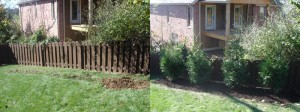Need trees planted? You can count on Tree Solutions to do the job right. We know all the correct procedures to ensure that your new additions to your landscape can start right, grow strong and healthy, and thrive in their new setting.
Improper planting is the #1 cause of young tree death.
Whether you want to know the procedures we use, or you’re a do-it-yourselfer looking for a little instruction, we’re happy to provide the steps we perform when planting new trees.
Once the location has been selected, the hole to plant the tree in should be as deep and 2 times as wide as the size of the rootball. The larger size is to give the new tree broken up soil to begin growing roots in. Care must be taken not to glaze the sides of the hole with shovels or digging equipment. If glazing occurs, the sides of the hole should be broken up to provide easier growth for the roots. If left glazed, it can impede root growth and cause root girdling.
The root flare (the point where the trunk flares out into roots) should be planted at or slightly above ground level. Sometimes it’s necessary to gently dig into the top of the rootball to identify where the root flare is, as the tree was already planted too deeply in it’s nursery pot.
Ok, so now we’ve got our new tree’s home ready, it’s time to move the new planting into its planting hole and remove the rootball from it’s wrapping or container. Each method of growth presents it’s own difficulties in planting.
In potted trees it’s common for the root system to be growing in a circular pattern around the outside of the pot. If left this way, these roots will continue to grow in that pattern, and eventually choke itself out. All these circling roots should be unwound if possible, or trimmed if needed, so that the new root growth is outward, where it needs to be to feed and support the tree as it grows.
When planting trees with burlap or synthetic cloth wrapped root balls, it’s important to remove all the wrapping material, including the wire basket around the root ball. It is acceptable to leave the bottom third of the wire basket in place if removing it will break apart the root ball. If left in place these foreign materials can impair root growth, or cause root damage to the tree as it grows, causing poor vitality, a slow death, or failure if the roots have rotted. Removing all the packing materials without disturbing the root ball isn’t easy. It is important to the future health of the tree to perform each step as carefully as possible.
Now we’re ready to place the rootball in the hole, and arrange the roots so that they grow in the correct pattern, away from the trunk of the tree. Check again to see that the root flare is at ground level. Now we can begin gently filling in around the rootball and extended roots. Try not to damage any roots with rocks or clods of dirt, and we want the root system buried about six inches deep.
Now it’s time to water in the new tree. A good soaking is needed to provide the root system moisture to begin growing in it’s new home. When Tree Solutions plants your tree, we also include a vitamin and hormone supplement, to make sure the sapling has everything it needs to start right.
The tree is now planted, but we’re not done yet. Now we need to mulch the rootzone. Our Critical Rootzone Mulching page describes why this is necessary, and well as the procedures for proper mulching.
If needed the sapling can be supported with posts and rope or cable to prevent uprooting. Care must be taken to protect the bark and cambium at the attachment point, and the supports should be removed as soon as the tree is capable of supporting itself.
We hope this information is helpful, and we’d love to hear from you when you’re ready to add some new trees to your landscape.
Green Giant Arborvitae Planting
These four Green Giant’s were planted along the home owner’s back boundary to provide a vision block from the newly built house in view. They were planted using the procedures above, and mulched with dark colored wood chip mulch. One last note on tree planting, be sure to call 1 800 DIG RITE to have the planting area marked out, even if nothing is supposed to be in the area….We were lucky to discover a buried cable line before causing damage to it.

